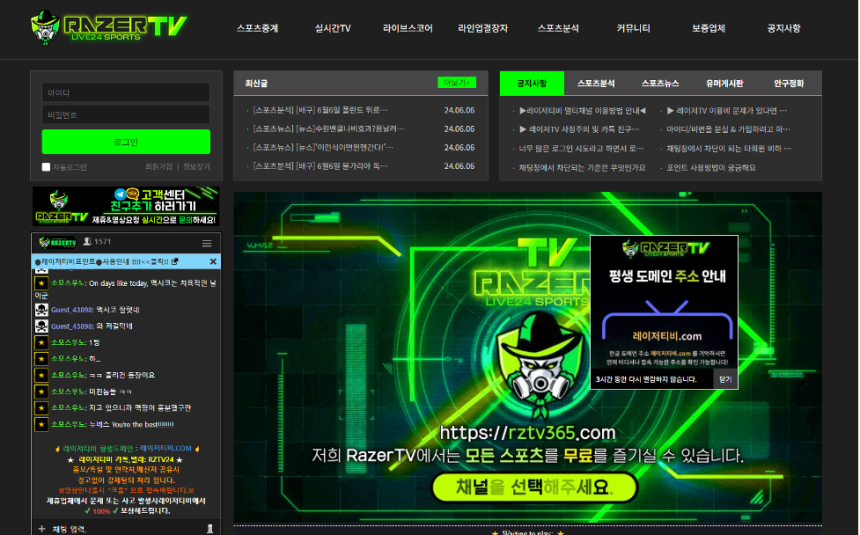In the digital age, the world of soccer broadcasting (해외축구중계) has experienced notable changes. With the rise of online platforms and streaming services, fans now have unprecedented access to their favorite teams and games. However, for those who are new to watching football broadcasts on the website, the process may seem difficult and complicated. This comprehensive guide details the essential steps and strategies to help you start running a successful soccer broadcast on your website and reach and engage with your fans like never before.
Understanding the online soccer broadcasting environment
Before we dive into the details of broadcasting soccer on your website, it’s important to understand the broader landscape of online sports streaming. The internet has revolutionized the way fans consume content, and football is no exception. Viewers now expect a high-quality, seamless streaming experience whether they watch on a desktop computer, smartphone, or smart TV.
To meet these expectations, broadcasters must become familiar with a variety of streaming protocols, such as Real-Time Messaging Protocol (RTMP) and HTTP Live Streaming (HLS), as well as popular streaming platforms such as YouTube, Twitch, and Facebook Live. Additionally, it is essential to understand the role of content delivery networks (CDNs) in ensuring a smooth, low-latency streaming experience.
Securing broadcasting rights and legal considerations
website football broadcasting (해외스포츠중계) is securing the necessary broadcasting rights and navigating the legal environment. Failure to do so may result in serious legal consequences and financial penalties.
The first step is to identify and negotiate with the appropriate rights holders, which may include leagues, clubs or governing bodies. It is important to obtain explicit permission to broadcast matches on your website as well as related content or highlights.
Broadcasters must also respect intellectual property rights, including trademarks, logos and copyrighted material. It is also important to obtain appropriate consent from athletes, coaches and other individuals who may appear on broadcast while complying with privacy regulations.
It is also important to thoroughly review and adhere to the terms of service and policies of the streaming platform you are using, as well as any geo-blocking measures required by your broadcast rights agreement.
Building a broadcast setup
Once you’ve secured the necessary rights and resolved any legal considerations, it’s time to configure your broadcast settings. Professional-grade equipment can provide superior quality, but beginners can start with less expensive options and gradually upgrade as their needs evolve.
- Camera: Invest in a high-quality camera that can capture soccer field action in clear detail. DSLR cameras or dedicated sports cameras are popular choices.
- Encoding software: To stream video content, you need encoding software that can convert your camera’s output into a streamable format. Popular options include Open Broadcaster Software (OBS) and XSplit.
- Audio Equipment: Clear, clear audio is essential for an immersive viewing experience. Consider investing in a high-quality microphone, mixer, and audio interface.
- Internet Connection: A stable, high-speed Internet connection is important for smooth streaming. Make sure your location has reliable internet access, or consider using a dedicated wired connection or cellular hotspot as a backup.
- Lighting and Camera Accessories: Proper lighting can greatly improve streaming quality. Consider investing in a portable lighting kit and camera accessories like tripods and lenses.
Stream optimization for quality and performance
Once you’ve finished setting up your broadcast, it’s important to optimize your stream for the best quality and performance. Here are some key considerations:
- Bitrate and resolution: Choose the appropriate bitrate and resolution for your stream based on your target audience’s internet connection and device capabilities. Higher bitrates and resolutions provide better quality, but may affect performance for viewers with slower Internet connections.
- Encoding Settings: Experiment with different encoding settings, including codec, frame rate, and key frame interval to achieve the right balance between quality and performance.
- Adaptive Bitrate Streaming: Implementing adaptive bitrate streaming allows viewers to automatically switch between different quality levels depending on their internet speed, ensuring a smooth viewing experience.
- Content Delivery Network (CDN): Consider using a CDN to efficiently distribute your streams to a global audience to reduce buffering and improve overall performance.
- Test and Iterate: Continuously test and iterate your streaming setup, monitor performance metrics, and gather feedback from viewers to identify areas for improvement.
Improve your viewing experience
Delivering high-quality streams is essential, but creating an engaging and immersive viewing experience is equally important to building a loyal audience. Here are some strategies to consider:
- Live commentary and analysis: Add depth and insight to your broadcasts by providing live commentary and analysis from knowledgeable experts or former players.
- Interactive Features: Implement interactive features such as live polls, Q&A sessions, and chat features to foster a sense of community and engagement among your viewers.
- Supplementary Content: Provides supplemental content such as pre-game and post-game shows, player interviews, behind-the-scenes footage, and more to provide a more comprehensive viewing experience.
- Social Media Integration: Integrate social media platforms into your broadcasts so viewers can share their reactions, comments, and experiences in real time.
- Branding and Sponsorships: Explore branding and sponsorship opportunities to drive revenue and improve the overall production value of your broadcast.
Build your audience and promote your stream
Once your streaming operation is up and running, the next challenge is building and maintaining an engaged audience. Here are some strategies to consider:
- Social Media Marketing: Use social media platforms to promote your stream, share highlights, and connect with your audience. Encourage your viewers to share and interact with your content.
- Email Marketing: Build an email list and utilize email marketing campaigns to keep your audience informed about upcoming games, special events, and exclusive content.
- Influencer Collaborations: Leverage your existing fan base and gain exposure by collaborating with influential figures in the soccer community, including players, coaches, and popular content creators.
- Search Engine Optimization (SEO): Optimize your website and stream content for search engines to increase discoverability and attract new viewers.
- Partnerships and Cross-Promotion: Explore partnerships with complementary brands or organizations for cross-promotion opportunities and expand your reach and audience.
Measure success and continuous improvement
As with any endeavor, measuring success and continually improving your website soccer broadcasting operations is essential for long-term growth and sustainability. Here are some key metrics and strategies to track for continuous improvement:
- Audience analytics: Monitor audience analytics, including viewership, engagement, and retention metrics to measure the effectiveness of your strategy and identify areas for improvement.
- Quality Metrics: Track quality metrics like bitrate consistency, buffering speed, and viewer feedback to ensure a smooth viewing experience.
- Revenue and monetization: If monetization is your goal, track monetization metrics such as ad revenue, subscriptions, or pay-per-view sales.
- Audience Feedback: Actively solicit feedback from your audience through surveys, social media interactions, and direct communication channels. Use this feedback to inform future content and programming decisions.
- Continuous Learning: Stay up to date on the latest trends, technologies, and best practices in the streaming industry by attending conferences, participating in online communities, and continually learning from industry experts.
Conclusion
Successfully broadcasting football on your website requires a combination of technical expertise, strategic planning, and a deep understanding of your audience’s preferences and needs. By following the guidelines outlined in this guide, you’ll be equipped to navigate the complexities of online broadcasting, deliver high-quality content, and build a loyal and engaged fan base.
Through dedication, patience and passion for the beautiful game, we can transform your website into a thriving hub for football fans, delivering unforgettable experiences and fostering a vibrant online community that transcends geographical boundaries.
Lynn Martelli is an editor at Readability. She received her MFA in Creative Writing from Antioch University and has worked as an editor for over 10 years. Lynn has edited a wide variety of books, including fiction, non-fiction, memoirs, and more. In her free time, Lynn enjoys reading, writing, and spending time with her family and friends.















